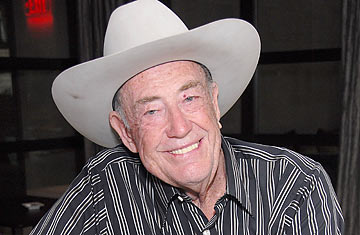
Poker Star Doyle Brunson
With his puppy-dog eyes and trademark cowboy hat, 75-year-old Doyle Brunson is one of the most recognizable players on the professional poker circuit. This summer marks the 40th annual World Series of Poker (WSOP), and the Texas native has competed in all but two of them — more than anyone else in the event's history — and racked up 10 championship bracelets, tied for second all-time. On the eve of this year's "Main Event," a $10,000 buy-in No-Limit Texas Hold 'Em tournament which starts July 3, TIME caught up with Brunson to talk about how the WSOP has changed over the years.
When was your first year at the WSOP?
I played the first one in 1970. We had two tournaments: the Main Event and a Deuce-to-Seven Lowball game. I don't remember how I did, but I know there were only six of us, including Jack Straus, Johnny Moss, and "Amarillo Slim." Back then everything was held at Binion's Horseshoe [now called Binion's Gambling Hall & Hotel]. It was more of a reunion; you knew everybody who came. When we weren't playing, we got together [socially]. Now I don't know anybody, and the whole thing is so big I wouldn't be able to find my friends if I did.
What do you remember most vividly about Binion's?
Of course I remember winning my two Main Event bracelets [in 1976 and 1977]. What made the place for me were the people. Except for [David] Sklansky, most of the guys I played against aren't playing these tournaments. Jack Binion is still my best friend, but he's never there, so I don't go down there much anymore.
How has the tournament changed since the good old days?
For starters, there are now 57 events, and it moved to the Rio [Las Vegas Hotel & Casino] in 2005. They also now play the Final Table in November so it can be on prime-time television. All of these changes were designed to accommodate and capitalize on a bigger field. The first year I did it, we couldn't even fill a table. They had something like 6,800 total entrants for last year's Main Event. In the beginning, it was always a bunch of touring pros in these. Now there are a lot of amateurs, some of whom are pretty good.
Does that mean the overall quality of play has improved?
Not really. More than anything, these kids are more aggressive, and it's getting harder to take the aggression away from them. Their style today is, "Bet, bet, bet." You can't bluff against that; you have to sit back and play smart poker and let these guys bury themselves. For me, this means not playing as many pots but playing them aggressively when I do come in. I call it being "tight-aggressive."
With this new strategy, would you say you've gotten better with age?
I know how lucky I am to be 75 and competing with these young kids. I don't think I've lost any of my mental acuity; the body is breaking down but the engine is still pretty good. That said, for me the Main Event isn't really about skill anymore — it's all about numbers. I can be the best player in the world, but because I'm Doyle Brunson, I have to jump too many hurdles to win. People read my books so they know how I'll play. They recognize me from TV, and they want to play a pot with me, so they call. It's like I have a bull's-eye on my forehead. I might be a three-to-one favorite to win hand after hand, but there's just no way that I'm going to hold enough good hands to win the whole thing. I can't overcome the magnitude of the numbers. I'd go so far as to say that it's almost impossible for me to ever win again.
So if that's the downside to a bigger field, what are the upsides?
It's good for poker, that's for sure. And it's nice to see so many people interested in our game. We love the fans.
I know you're on Twitter (@TexDolly). How have social networking sites changed the game?
They've certainly made it more accessible. A lot of the other pros will Tweet about the hands they won and the hands they held when they got beat. I don't have the time or patience to do that. I get up in the mornings, and go to my computer and usually spend an hour online. That's when I go to Twitter and put some thoughts in there. I try to answer most of the sensible questions that fans send me. It's a great way to connect with them. And you know what? Sometimes I even learn something.
